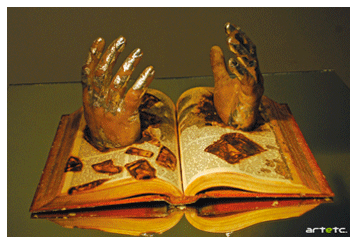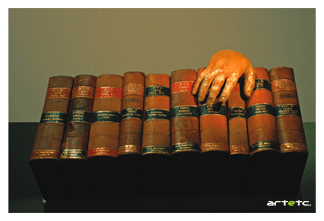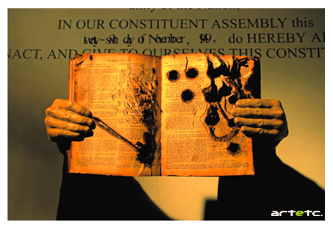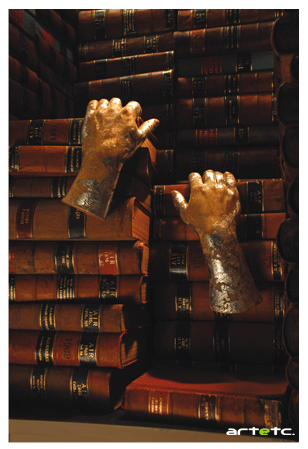- Editorial
- Shibu Natesan Speaks on Protest Art
- Rising Against Rambo: Political Posters Against US Aggression
- Transient Imageries and Protests (?)
- The Inner Voice
- Bhopal – A Third World Narrative of Pain and Protest
- Buddha to Brecht: The Unceasing Idiom of Protest
- In-between Protest and Art
- Humour at a Price: Cartoons of Politics and the Politics of Cartoons
- Fernando Botero's Grievous Depictions of Adversity at the Abu Ghraib
- Up Against the Wall
- Rage Against the Machine: Moments of Resistance in Contemporary Art
- Raoul Hausmann: The Dadaist Who Redefined the Idea of Protests
- When Saying is Protesting -
- Graffiti Art: The Emergence of Daku on Indian Streets
- State Britain: Mark Wallinger
- Bijon Chowdhury: Painting as Social Protest and Initiating an Identity
- A Black Friday and the Spirit of Sharmila: Protest Art of North East India
- Ratan Parimoo: Paintings from the 1950s
- Mahendra Pandya's Show 'Kshudhit Pashan'
- Stunning Detours of Foam and Latex Lynda Benglis at Thomas Dane Gallery, London
- An Inspired Melange
- Soaked in Tranquility
- National Museum of Art, Osaka A Subterranean Design
- Cartier: "Les Must de Cartier"
- Delfina Entrecanales – 25 Years to Build a Legend
- Engaging Caricatures and Satires at the Metropolitan Museum
- The Mesmerizing World of Japanese Storytelling
- The Metropolitan Museum of Art Exhibiting Lyrical Visions: Paintings from North India
- Random Strokes
- Asia Week at New York
- Virtue of the Virtual
- What Happened and What's Forthcoming
- Art Events Kolkata, March – April 2012
- Mumbai Art Sighting
- Art Bengaluru
- Delhi Dias
- Preview, April, 2012 – May, 2012
- In the News, April 2012
- Cover
ART news & views
Editorial
Issue No: 28 Month: 5 Year: 2012
It has been an enriching and rewarding journey over the last three months as I sat on my table editing the three issues of Art Etc. news & views dedicated to Protest Art. I have observed much and remembered more, but what excited me most was the way I came across and learnt so many things.
It was such a well rewarding experience to revisit Frida Kahlo, Jane Alexander and the graffiti art of the MENA countries through a new perspective. I have also touched upon the American Object Orange movement, which is a way to protest against the dwindling of heritage buildings in Detroit. Then there has been the Russian Peredvizhniki, often called The Wanderers or The Itinerants in English, a group of Russian realist artists who in protest against academic restrictions formed an artists' cooperative and finally evolved into the Society for Travelling Art Exhibitions in 1870 and was active till 1890. This was the first issue.
The second one presented me with quite a few roadblocksas I aspired to achieve more. To get actual protest artistsreticent though they may be to talk for themselves. It was hard to get the Guerilla Girlsa feminist art movement worldwide, where female artists put the Gorilla mask of anonymity to protest against male chauvinism in the art world. It was also a challenge to get the reticent South African artist Willie Bester, whose art is a constant reminder of the atrocities of the Apartheid days. We focussed on the protest of Chinese artists, to two German filmmakers who are documenting the Japanese protest pattern after the Fukushima-Daichi accident. At the same time, we took a keen look at the angst-ridden photographic art of Rameshwar Broota and was really surprised to find out how the Partition failed to affect Indian artists of the forties, except Satish Gujral, whose works on the subject has also significantly been few. I have also focussed on groups, like the Bengal artist of the '40s, Transgressive art as a form of protest, Ai Weiwei, Communalism as a movement which started in India after the Best Bakery and Babri Masjid incidents and the canvas of Manjit Bawa after the Sikh riots in Delhi.
In this last and final edition of Protest Art, I have turned the focus to closer home - India, and other Asian countries. At the same time, I have included aspects of European and American Protest Art, thus giving the issue a global perspective.
Hence the subject of protest concerning Irom Sharmila finds equal importance beside the Dadaists of Zurich. The art erupting out of the Bhopal gas tragedy is laid side by side with the stark portrayal of American torturers at the Abu Ghraib prison after the fall of Saddam Hussain.
The issue also brings to attention the socio-political situation highlighting the genre of poetry and songs along with the visual renditions of some of the most important artists from Bengal.
Side by side with this, I thought it will be fitting in these days of political upheaval in Bengal centering round a particular morphed photograph, to include an article on political cartoons and the way they have had an impact on our societyfrom Shankar to Laxman and others.
Then there is the promised article on the Dadaists, headed by Raoul Hausmann, whose utterings against authority gave rise to a worldwide movement in Protest Art during and after the World War I. What was interesting to note is that Hausmann used techniques in the days of preliminary technology to create art that can well be compared with the most cutting-edge art and installations of today.
Editing these three issues, I came to realize how protest after a certain point of time, speaks almost in the same language. Thus, when I juxtaposed Ferrando Botero's paintings concerning the Abu Ghraib tortures, Thiyam Debendra Singh's depiction of Spirit of Sharmila, and Sayyad Irshad Ali's Public Art Work in BhopalI saw how the colours, the tones and the angst depicted themselves almost similarly. Pale yellow, muted blackish brown and a splash of blood-redthey are always present. Yes, we have separate articles on the protest art of north-east India, the Abu Ghraib episode and the Bhopal Gas Tragedy, but somehow, somewhere in this world of ours, it again proves that art speaks the same language.
There are separate sections on Civil Society Protest covering the whole gamut from the American atrocities during the Vietnam War to the art from colonialized Senegal, covering Mona Hotum, Purvis Young, Shireen Neshat, Dorothea Lange to Norman Carlberg. Beside this, there is an interesting article on India's most famous graffiti artist, who goes by the name of Daku. And then of course there are other sections on poster art, Urban protest in Italy, Protesting through new media, the Protest art by contemporary Indian artists like Jitesh Kallat, Riyaz Komu, TV Santhosh and others.
We also take a close look at the works of Mark Willinger, Bijon Chowdhury: and Baptist Coelho, beside trying to understand how painting can be a tool of social protest and initiating an identity.
With these of course are our regular features, market trends, insights, and auction news.
I sincerely hope that this journey over three months has been a most rewarding experience for you dear reader, as it has been for me.
Vikram Bachhawat




Bone Mill Tales, Installation in eight parts, Found object, fiber-glass, wood, mirror, ceramic.
In his Installation ‘Bone Mill Tales’ initially called ‘Kaata Koler Kaeccha’ in the vernacular, Chhatrapati Dutta extends a personal saga into a field of common experience. Playing the role of an excavator he digs deep into the slippages and shadows of time and retrieves the forgotten memories of our history, questions it and makes the unseen visible. The symphony of material within the space of its existence turn into a silent, but public testimony, to the voice of citizens that are ground to naught by the well-oiled wheels of the institutional bone mill. It is a universal story of many that are silenced. It is also the story of the individual versus the judiciary – the story of justice denied.